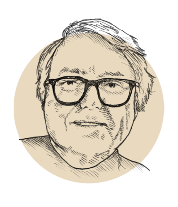Dateline: Friday December 18, 2020. The FDA recommends emergency vaccine approval in the U.S., Cyclone Yasa batters Fiji, Brexit talks in London stall yet again, Italy braces for a nationwide Covid lockdown. Meanwhile, in France, one story dominates: Jean-Pierre Pernaut is anchoring his last TV news bulletin. The headline even eclipsed President Macron’s positive test for coronavirus. So, adieu, JPP. Why all the fuss? Because the departure of France’s best-known newscaster sheds intriguing light on public perceptions of the media and its role.
Largely unknown outside France, Jean-Pierre Pernaut has for decades been a trusted household name nationwide as the presenter of le Journal de 13 heures, the 1 p.m. news bulletin on the TF1 television channel. He may not, perhaps, rank in the same league as “serious” journalists and news anchors – those who host the prestigious primetime evening news shows – but he has been an integral part of the national media landscape, or PAF, for more than 30 years. During Pernaut’s tenure, his lunchtime slot became the most-watched newscast in France, earning some of the highest audience ratings in Europe for this type of broadcast.
What made Jean-Pierre Pernaut so popular (he was ranked third in a 2020 list of the 100 most popular French people), in both senses of the term, was his focus on la France profonde, and the everyday concerns of ordinary folk outside the navel-gazing capital. War, famine, natural disaster, even pandemics were given short but highly professional shrift, in favor of local-interest stories appealing to the widest possible audience: flower shows and agricultural fairs, time-honored and picturesque villages, centennial birthdays and diamond weddings. And, of course, food and regional cuisines. ( JPP’s final bulletin reported that people were buying smaller birds, not turkeys, to eat at Christmas because health-related restrictions were limiting family gatherings.) When asked about his fondness for homespun storytelling, Pernaut recalled the advice he once received from a wizened shepherd: Tout homme qui ne se retourne pas sur ses racines est perdu (any man who does not go back to his roots is lost). JPP’s favorite word was proximité.
For a U.S. observer, it may seem puzzling that a national network covering weighty stories in its regular news bulletins should devote the noon timeslot to such downhome, folksy material. But Pernaut’s show promoted a deep-rooted sense of French identity – and was also popular with the key audience for advertisers, the so-called WDM<50 category, or “women under 50 purchasing decision-makers.” In other words, le JT de 13h – later renamed le 13h de Jean-Pierre Pernaut – was a global-local show that drew a faithful, advertiser-friendly audience. And while JPP may have been snubbed by the glamourous Paris-based media crowd, he was blithely immune to their condescension.
In terms of the media, France is structurally different from America. A recent comparative study by Institut Montaigne found that a core group of elite, well-established French publications and news outlets set the agenda for the rest of the media ecosystem. At a time when fake news and polarized coverage are posing a serious threat, the study’s authors concluded that this elite group was an impressive and effective rampart against popularism. On the downside, those same core outlets are so used to deciding what should be reported and discussed that they tend to overlook important stories far-removed from traditional centers of power. In other words, they focus on politics “as it should be” rather than what is happening on the ground. Pernaut’s enduring success may be attributable to that sense of proximity.
His sign-off broadcast was tearful, as he told the audience that he loved them and would never forget them. His replacement at the 1 p.m. slot, Marie-Sophie Lacarrau, has a tough act to follow, though she too has impressive credentials due to her formative years in local and regional public TV. And, by her own admission, she shuns the soirées mondaines that attract the capital’s movers and shakers.
Article published in the February 2021 issue of France-Amérique. Subscribe to the magazine.












